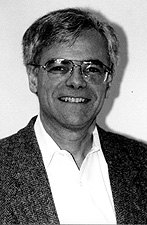
THERE IS PROBABLY NO
BETTER WAY FOR AN
NIH SCIENTIST TO KEEP
IN TOUCH WITH NEW
DEVELOPMENTS IN
BIOMEDICAL RESEARCH
THAN TO ATTEND ALL
OF THE WEDNESDAY
AFTERNOON LECTURES.
| T H E N I H C A T A L Y S T | J U L Y – A U G U S T 1997 |
|
|
|
| F R O M | T H E | D E P U T Y | D I R E C T O R | F O R | I N T R A M U R A L | R E S E A R C H |
INTERINSTITUTE GROUPS SPARK INTEREST
 |
| Michael Gottesman |
|
THERE IS PROBABLY NO BETTER WAY FOR AN NIH SCIENTIST TO KEEP IN TOUCH WITH NEW DEVELOPMENTS IN BIOMEDICAL RESEARCH THAN TO ATTEND ALL OF THE WEDNESDAY AFTERNOON LECTURES. |
Over the past four years, the burgeoning diversity and vitality of NIH’s specialized scientific interest groups have greatly enhanced the research climate here, and I am pleased to give you a status report on our interinstitute interest groups.
In addition to seven broadbased interinstitute interest groups (Cell Biology, Molecular Biology and Biochemistry, Genetics, Structural Biology, Immunology, Neurobiology, and Clinical Research), there are now 65 established, smaller specialized interest groups at NIH and another nine that are just coalescing (for a complete list, see Interest Group Directory). That means—since we have about 1,200 tenure-track and tenured scientists—that there’s one interest group for every 15 or so principal investigators. Some of these smaller groups—like the venerable Lambda Lunch—date back 30 years or more; others deal with scientific subjects that didn’t even exist a few years ago.
Most of our specialized interest groups meet regularly to share ideas, discuss papers, and listen to seminars of mutual interest. In so doing, they allow scientists in different intramural programs who share common techniques or who have common intellectual interests to exchange ideas and materials. Active web sites, listserve lists, and other electronic communications facilitate these exchanges. More and more, our interest groups are an important and impressive scientific face NIH shows the world, as they respond to queries from outsiders and provide points of contact for scientific collaborators.
Dr. Varmus and I have also relied on the interest groups as advisors on scientific matters. The larger interest groups each recommend and host three outside speakers (many of whom are initially nominated by the smaller groups) for the Wednesday Afternoon Lectures, and the smaller groups themselves recommend an additional six speakers. This nomination process has led
to an outstanding and diverse lecture series. There is probably no better way for an NIH scientist to keep in touch with new developments in biomedical research than to attend all of the Wednesday Afternoon Lectures. Starting with the next round of nominations, the interest groups will also be proposing speakers for the prestigious NIH Director’s Lectures, also held as part of the Wednesday Afternoon Lectures.
I depend on the interest groups to give me advice about new scientific projects for NIH, to provide reviewers for promotion and tenure actions at NIH, and to provide ideas and organizational skills for the workshops and symposia that make up our annual NIH Research Festival. This year, Structural Biology and Immunology will organize the Research Festival symposia, and 20 of the smaller groups will organize workshops and select presentations for the poster sessions. Dr. Varmus and I also meet annually with interest group leaders to explore other ways in which their work can be facilitated and their expertise tapped to advance NIH’s missions.
We are now considering a new interest group advisory function, arising from planned changes in the Fogarty Scholars program. Currently, Fogarty Scholars are selected and supported by the Fogarty International Center. In the future, we would like scientists at NIH, through the interest groups, to have a much greater voice in choosing and hosting Fogarty Scholars. In this model, the interest groups would nominate Fogarty Scholars to come to NIH for a sabbatical period, with financial support from one or more intramural programs. This would allow scientists at NIH to select scholars whose work sparks their interest, guaranteeing a constituency of NIH intramural scientists eager to interact with the Fogarty Scholars. And since funds for the program would come from several different institutes, we might well be able to bring more scholars to NIH than is currently possible. I am working with the Fogarty International Center, the scientific directors, and some interest group leaders to develop a process to support this program.
Finally, one way to think of the larger interest groups is as faculties. Several have already taken action to help train colleagues and postdoctoral fellows in their discipline. Through the network established by the interest groups, fellows and students receive training, mentoring, and a perspective on their field that may not be available in their own laboratories. More formal programs to achieve these goals are encouraged. One obvious possibility would be to use the interest groups as faculties to support a graduate program at NIH. Although plans for such a graduate program are still embryonic, a program that builds on the strength of NIH in translational research is an enticing possibility. Whether NIH hosts student researchers from other degree-granting programs or develops its own graduate program, the expertise in the many disciplines represented by the specialized interest groups and the coursework available through the FAES graduate school are keys to a successful program.
I welcome other ideas
you might have for using the interest groups at NIH. And if this discussion
has encouraged you to establish a new interest group, please get in touch with
the "Csarina of the Interest Groups," Celia
Hooper. ![]()